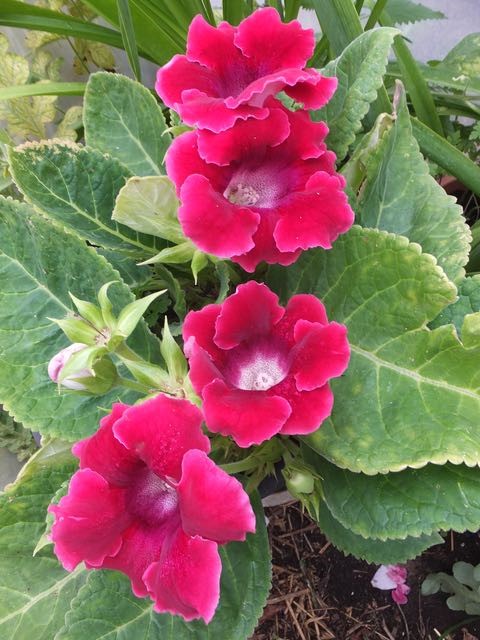
The quintessential greenhouse flower is Gloxinia. This tropically splendid beauty produces wonderful displays of luxuriant blooms. Each large almost wineglass shaped flower has fleshy petals with a velvety sheen. As the petals fade the flower drops leaving an attractive star shaped calyx.
These were discovered in Brazil and South America and introduced to our Greenhouses, or rather our Stove-houses, in the first part of the nineteenth century. Once known as Gloxinias these are less often seen today, maybe the name change to Sinningia didn’t help. And maybe because they are a tad finicky. These can just about succeed as houseplants ideally sat on a sunny windowsill behind net curtain. But they’re happiest in light dappled shade in a bright warm greenhouse. However given that warmth (never less than 75F/22C) and a constant moist never damp atmosphere these can flower from May through till October.
I say fickle and it’s true, these need the right conditions or they fail quickly, the large almost woolly leaves are prone to water damage and worse, are brittle so easily lost or damaged. Over-watering, tap water not rain, or just using cold water not warm, risks losing the plants. Their compost needs extra sand and plentiful leaf mould, in a wide shallow, preferably ceramic pot. They need regular watering, remember warmed, from late winter till mid autumn then must be dried off till the next year. Light feeding is needed all summer to keep up the flowering.
Pests, other than aphids and sometimes mealy bugs, are not a problem it’s the miffiness. A draughty spot can debilitate then kill, too dry air causes the leaves to brown and curl, humid is best but drops of water spoil everything they touch.
So why bother? Because they are so beautiful for so long. Gloxinias are simplest bought as going plants in season, or as rhizomes and forced in warmth from late winter being just buried an inch or so under their compost. They can be grown from seed though not easily, leaf or stem cuttings are quicker and give true offspring which is important as there are so many improved sorts. The connoisseur can find dozens of varieties and many other species of Gloxinias and Sinningias to enjoy in red, purple, blue and white.
Oh yes, the names, Gloxin was a botanist at Colmar, Sinning was a gardener at the University of Bonn.


